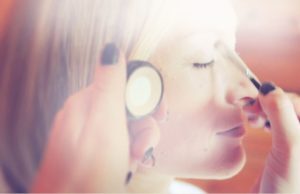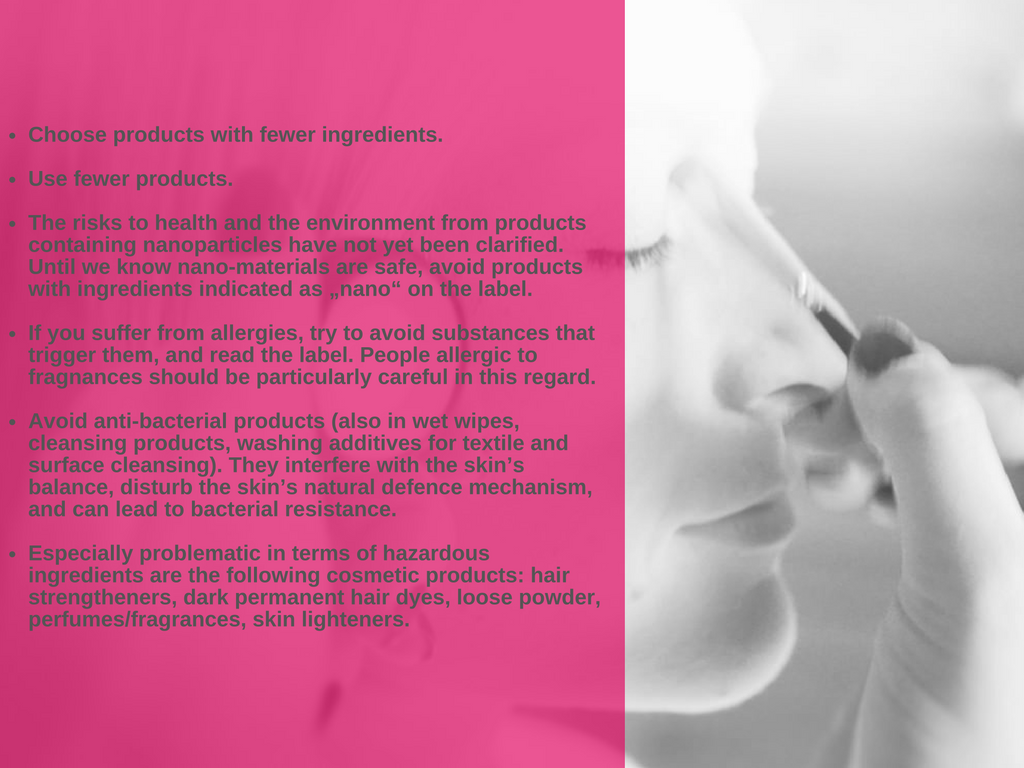Are we taking good care of our body?
An average person is using some 20-25 types of cosmetics and toiletries products which can contain up to 200 ingredients! Most of them come into direct contact with our skin, others are also inhaled. What do we know about possible health effects of these chemicals?
The problem
Cosmetics like shower gels, deodorants or toothpaste are an integral part of our everyday lives. It is important that they are safe for daily use, as they are in direct contact with the skin and mucous membranes, and some ingredients can pass through the skin, into our bodies. Some products are used as sprays or aerosols and could also enter the body via inhalation.
There are a multitude of products for hair, skin cleansing and body care. Even if most cosmetic ingredients are listed on the packaging with their technical terms, safe products are not immediately recognizable. The labels are often hard to read and can be confusing for the consumer. Some ingredients can have irritating or allergenic effects or are suspected of being endocrine disruptors (endocrine disruptors are chemicals that interfere with the hormone system and can cause tumors, birth defects, and other developmental disorders) or carcinogenic (causing cancer).
Regular contact with harmful substances, for instance when using cosmetic products on the skin may lead to their absorption into the body. The more chemicals that are absorbed the more likely it is that they might impact our health. Therefore, it is useful to reduce contact with hazardous chemicals in e.g. cosmetic products, if possible.
- Shampoos and bath additives: Shower gels may contain the sodium lauryl sulphate which may dry out and irritate sensitive skin. They may contain preserving agents and fragrances which are potentially allergenic, hormonally active or carcinogenic.
- Lotions, creams and oils: Skincare products often contain synthetic mineral oils that can accumulate in the body and be damaging to your health. Allergenic fragrances are problematic as well: You can find a list under “Avoid harmful substances”. Preservatives like parabens can disrupt the hormone system. Many day creams supposed to protect the skin from UV damage may contain chemical UV filters which can accumulate in the body and disrupt the hormone system
- Deodorants and perfumes: Deodorants act against the bacteria responsible for odour development using preservatives like formaldehydes or formaldehyde releasers and alcohol. Alcohol can irritate and dry out sensitive skin and some odour covering fragrances are allergenic. Musk compounds are persistent, i.e. they can accumulate in the environment and in the body. Deodorants and perfumes can contain endocrine disrupting phthalates which are used as denaturants and don’t have to be listed on the label.
- Sunscreens: Sunscreen provides protection from UV radiation that can cause skin cancer. In sun lotions, chemical filters and mineral pigments are responsible for that protection. Some chemical filters like benzophenone-3 (oxybenzone) disrupt the endocrine (hormone) system and accumulate in the body. Caution is advised with mineral UV protection containing titanium dioxide or zinc oxide be present as nanoparticles because the possible health effects are not yet fully known.
- Toothpaste and mouthwash: Toothpaste contains mechanical abrasives and surfactants, fragrances, flavors, sweeteners and preserving agents, as well as fluoride which supposedly prevents cavities. Preservatives are used to prevent dental plaque; but the potentially harmful substances are triclosan or chlorhexidine. Also mouthwash can contain preservatives and alcohol.
HAZARDOUS CHEMICALS IN COSMETICS
List on allergens
At present, it is mandatory that 26 allergenic fragrances are listed individually on the packaging with their INCI names. However, it is not required to indicate that they might be allergenic chemicals.

Tips & Tricks

Possible health effects
Men, women and children are directly exposed to hazardous chemicals in cosmetics – through skin, inhaling and even ingestion. Some ingredients have irritating or allergenic effects or are suspected of being endocrine disruptors, or have been linked to cancer. Reddening, blisters and itchy skin areas can be first signs of an allergic reaction to a cosmetic ingredient. Some of these hazardous chemicals may end up in the environment, accumulate there over time and cause potential damage to living organisms.
Properties
Preservatives
Hazardous chemicals (INCI*)
Parabens (e.g. Methylparaben, Butylparaben, Propylparaben)
Possible health effects
Estrogenic effects, disrupts
Used in products
Shampoos & bath additives; toothpaste; sunscreen; lotions, creams & oil; deodorants & perfumes
Properties
Preservatives
Hazardous chemicals (INCI*)
Phenoxyethanol
Possible health effects
Irritating after prolonged exposure, neurotoxic, allergenic
Used in products
Shampoos & bath additives; sunscreen; lotions, creams & oil; deodorants & perfumes
Properties
Preservatives
Hazardous chemicals (INCI*)
Chlorhexidine, Digluconateor Cetylpyridinium Chloride
Possible health effects
Irritating, can cause allergies and lead to tooth discoloration
Used in products
Shampoos & bath additives; toothpaste; lotions, creams & oil
Properties
Preservatives
Hazardous chemicals (INCI*)
Formaldehydes and formaldehyde releasers (e.g. benzylhemiformal, 2-bromo-2-nitropropane-1,3-diol, 5-bromo-5-nitro-1,3-dioxane, diazolidinyl urea, Imidazolidinyl urea, Quaternium-15, DMDM Hydantoin)
Possible health effects
Irritates mucous membranes and skin, can cause hypersensitivity, carcinogenic (nasal pathway)
Used in products
Shampoos & bath additives; toothpaste; sunscreen; lotions, creams & oil; deodorants & perfumes
Properties
Preservatives, antiseptic
Hazardous chemicals (INCI*)
Triclosan
Possible health effects
Can cause allergies and bacterial resistance
Used in products
Shampoos & bath additives; toothpaste; deodorants & perfumes
Properties
Surfactants, detergents
Hazardous chemicals (INCI*)
Sodium Lauryl Sulfate (SLS, Sodium dodecyl sulfate; Sulphuric acid, monododecyl ester, sodium salt; Sodium salt sulphuric acid; Monododecyl ester sodium salt sulphuric acid), Ammonium lauryl sulfate (ALS), Sodium Laureth Sulfate (SLES), Cocamidopropylamine Oxide
Possible health effects
Irritates and dries out the skin
Used in products
Shampoos & bath additives; toothpaste
Properties
Surfactants, detergents
Hazardous chemicals (INCI*)
Ethylene oxide, 1,4 Dioxane (by-product of SLS, myreth, oleth, laureth, ceteareth, PEG, polyethylene, polyethylene glycol, polyoxyethylene, oxynol)
Possible health effects
Probably carcinogenic to humans, toxic to the brain and central nervous system, kidneys and liver. It is also a leading groundwater contaminant
Used in products
Shampoos & bath additives; toothpaste
Properties
UV-filters
Hazardous chemicals (INCI*)
Benzophenone-3(oxybenzone)
Possible health effects
Biochemical or cellular level changes, disrupts the endocrine system, accumulates in living organisms (e.g. breast milk) and in the environment
Used in products
Sunscreen; lotions, creams & oil
Properties
UV-filters
Hazardous chemicals (INCI*)
3-Benzylidene camphor(3 BC)
Possible health effects
Disrupts the endocrine system, accumulates in living organisms (e.g. breast milk) and in the environment
Used in products
Sunscreen; lotions, creams & oil
Properties
UV-filters
Hazardous chemicals (INCI*)
4-Methylbenzylidene camphor (4-MBC)
Possible health effects
Disrupts the endocrine system, is persistent and accumulates in living organisms (e.g. breast milk) and in the environment
Used in products
Sunscreen; lotions, creams & oil
Properties
UV-filters
Hazardous chemicals (INCI*)
Octyl methoxycinnamate (OMC, Ethylhexyl-methoxycinnamate, Octinoxate)
Possible health effects
Disrupts the endocrine system, accumulates in living organisms (e.g. breast milk) and in the environment
Used in products
Sunscreen; lotions, creams & oil
Properties
UV-filters
Hazardous chemicals (INCI*)
Octyl-Dimethyl-para- Aminobenzoic-Acid PABA(OD-PABA)
Possible health effects
Biochemical or cellular level changes, multiple additive exposure sources, can cause photo allergic reaction
Used in products
Sunscreen; lotions, creams & oil
Properties
Hazardous chemicals (INCI*)
Nano titanium dioxide,nano zinc oxide
Possible health effects
Indications for toxic effects in cells, accumulation in the body – health risks are currently unknown
Used in products
Toothpaste; sunscreen; lotions, creams & oil
Properties
Perfume, scent
Hazardous chemicals (INCI*)
Fragrances, musk compounds,parfum
Possible health effects
Allergy risk, irritate the skin, accumulates in the environment, the body & breast milk, some can disrupt the endocrine systemNB! These compounds if they are not from natural sources can contain solvents and denaturant agents e.g. Phthalates, which have no labelling obligation. These substances disrupt the endocrine system, potentially sensitising
Used in products
Shampoos & bath additives; toothpaste; sunscreen; lotions, creams & oil; deodorants & perfumes
Properties
Mineral oils
Hazardous chemicals (INCI*)
Paraffinum liquidum, wax
Possible health effects
Not broken down by the human body. Accumulates in the lungs, liver and lymph nodes
Used in products
Shampoos & bath additives; sunscreen; lotions, creams & oil; deodorants & perfumes
Properties
Chelating agent
Hazardous chemicals (INCI*)
EDTA (Disodium EDTA)
Possible health effects
Accumulate in the body and in the environment
Used in products
Shampoos & bath additives; toothpaste; sunscreen; lotions, creams & oil; deodorants & perfumes
*INCI name – International Nomenclature of Cosmetic Ingredients
Important sources for this table: Dutch Environmental organisation, Dutch State institute for Healthcare and environment, SINlist Chemsec, a new Dutch institute for Food and Consumer products

